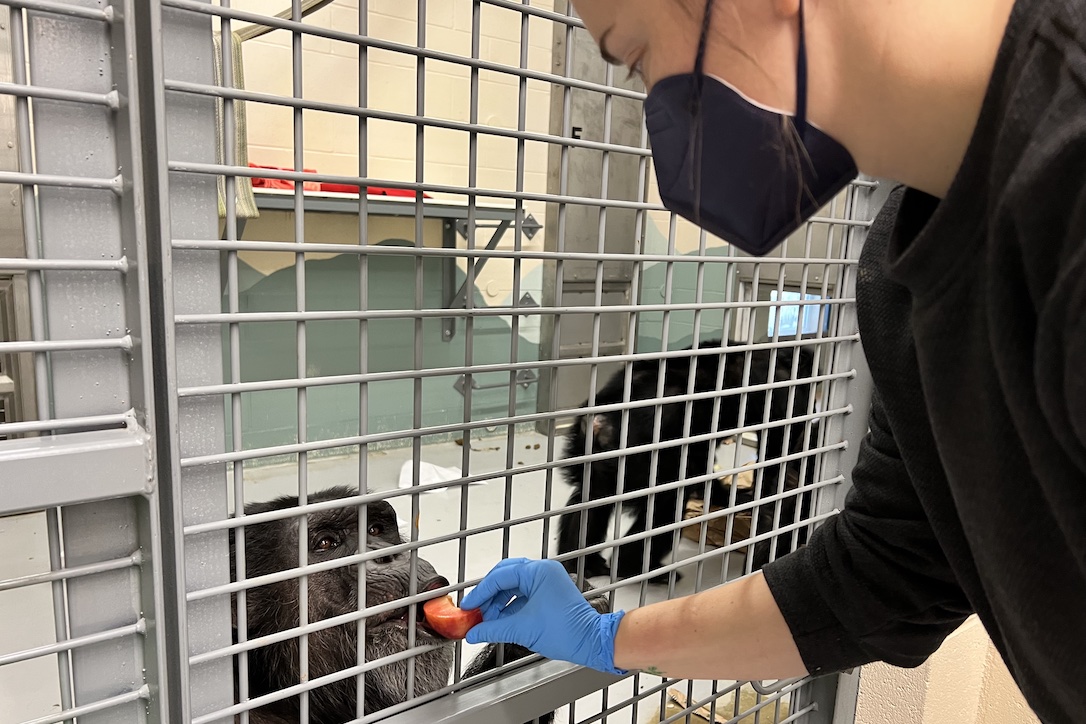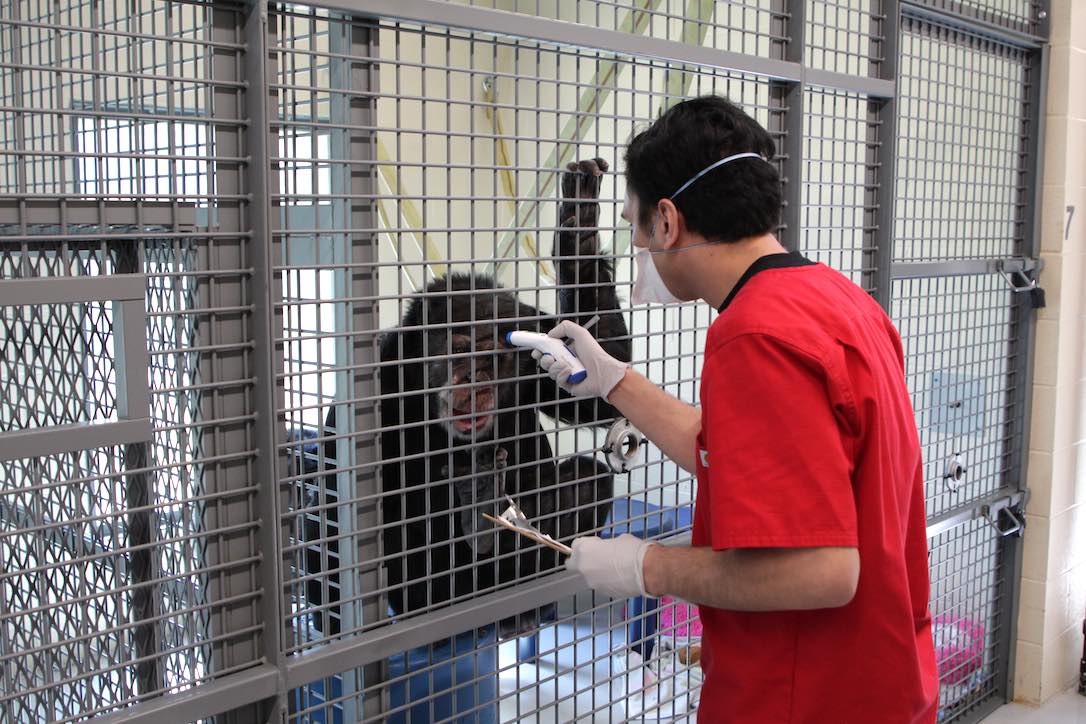Every time I meet a new person and explain my job to them, it is inevitable that they ask about how much contact I have with the chimps. Lots of questions come up, such as, “Do you hug them?”, “Do you hold them?”, or “So you just sit and hang out with them?”. If you are new to our blog and our sanctuary’s mission, the quick answer to all previous questions are NO. At all times, caging separates the chimps and the humans (unless they are under anesthesia). This is for everyone’s protection. Chimpanzees, on average, are 3-8x stronger than humans. Unintentionally (or intentionally), a chimpanzee could easily hurt us.
Any physical contact we have with the chimps is done in a safe manner based on strict protocols.
One example, is grooming. We often let the chimps groom us as it is a natural behavior for them to strengthen relationships and remove debris or parasites from one another. To groom with them safely, we will allow them to groom the back of our closed hand, with the chimp’s fingers fully extended, or use a tool from a safe distance.
Grace and Rayne demonstrating this perfectly:
Jamie grooming Grace with a tool:
We often also let the chimps groom our shoes. We have a few chimps (like Terry, Jamie, and Lucky) who absolutely love footwear. To let them groom our shoes safely, we will present our shoes to them from a safe distance (where they can only touch, not grab or pin). We do not put our feet up against the caging, but only close enough where they can touch the boots with their fingers extended.
Terry grooming boots:
Another way we may physically interact with the chimps is through play.
Burrito’s favorite game is to poke the back of our hands, as fast as he can. I’m sure you have seen many videos of this over the years. Again, to do this in a safe way, we ensure our fingers are tucked and Burrito’s finger is fully extended. We also make sure to not push our hand against the caging but only where he can reach us from a safe distance.
J.B. and Burrito:
Chad and Burrito:
Playing tug of war allows us to hold onto the end of a blanket or scarf from a safe distance, while still being fully engaged with a play session with a chimp. We make sure to not wrap the material around us in any way, to avoid unexpectedly being pulled close to the caging. We also ensure we are fully balanced on our feet before beginning to play. If the chimp pulls hard on the blanket to win the game of tug of war, we immediately let go so we don’t get too close to the caging.
Dr. Erin and Burrito playing tug of war
Food
We hand-serve all of the meals to the chimps. This is the best way to ensure each chimp is getting their own food portions. To serve the food in a safe way, we use two fingers to grab the item at the furthest point, and then push through the caging where the chimp’s hand awaits. That is quite hard to explain. Here are some pictures that show this process!
Grace serving Cy:
Anthony serving Foxie a smoothie (with his hand at the bottom of cup only):
Positive Reinforcement Training (PRT)
Positive reinforcement training is a wonderful tool to allow the chimps to participate in their own medical care. While doing PRT, we can do everything at a safe distance and we never put our fingers inside the caging.
Chad taking Mave’s temperature:
J.B. asking for Burrito’s foot during PRT:
So while we limit our direct physical contact with the chimps, it is for both parties safety, to respect their space, and to let them be chimps! If you do see content online or in-person where the humans are directly next to a chimpanzee without caging, you should be questioning the type of facility the chimp is in. It is not an accredited zoo or sanctuary if you are seeing this type of content.
A gentle reminder, primates are not pets.
















For some reason while viewing this blog my mind wandered to Jane Goodall, whose early years at Gombe were spend at times playing with the chimps she was studying. You see her roughhousing with mostly infants and younger chimps. She does admit to have been physically attacked and hurt by Frodo. I know we are talking apples and oranges–“our” chimps are graduates of the labs, hers were free roaming who had rarely if ever even seen a human before she began to study them. And she did seem to if not actually anthropomorphize at least feel that the chimps she studied acted in ways similar to humans. Perhaps she meant that we act as chimps do as much as they act act as we do. However, I doubt today she would be handling the chimps as she did then. Fascinating to read up again on her research. I read about her interest in chimp sanctuaries and IIRC spoke via zoom or whatever preceded zoom about the good work Chimpanzee Sanctuary Northwest was doing. Perhaps this was even covered in an early CSNW blog.
Mark: Did you ever see the touching photos of a Chimp being release in the wild who looked out at the freedom ahead of him and turned around and jumped on the crate and gave Jane a hug to thank her. Tears coming to my eye even as I just think about it. Beautiful moment that probably no other human has ever experienced.
when Burrito was injured by a rattlesnake (twice),, what method did you use to retreive him from Young’s Hill?
He brought himself inside and we were able to isolate him from there!
I recall a video from a zoo, there was a certain horn used in case of an emergency where, when heard, all of the chimpanzees immediately went back indoors. They certainly had to be trained to do that. I am wondering if there is a certain alarm or horn or some such sound that our chimps understand to mean ‘come indoors immediately’ ?
We have a bell that we use to recall the chimps from the hill. It is apart of PRT, where they know when they hear the bell we want them to come inside for whatever reason, and then we give a higher reinforcement item, such as a full banana, for doing so.
That’s so interesting! Do you think sometime you might explain to us exactly how you train for that?That’s so interesting! Do you think sometime you might explain to us exactly how you train for that?
Mark: Did you ever see the touching photos of a Chimp being release in the wild who looked out at the freedom ahead of him and turned around and jumped on the crate and gave Jane a hug to thank her. Tears coming to my eye even as I just think about it. Beautiful moment that probably no other human has ever experienced.
All one needs to do is look at, for example, Foxie’s missing ear portion as well as the chimps with missing digits to better understand the harm a chimpanzee can inflict on another. To be ever vigilant of your actions and surroundings takes mental energy. You caregivers must go home physically and mentally exhausted. Also, this post makes me think of the post Tobin often refers to, the PSA of Jamie demonstrating why chimps do not make good pets. It’s funny while being dead serious. And who better to teach this message than our beloved Boss Lady?!
Every time someone sees baby perting zoo chimps online and says “I want one!” I refer them to that vídeo
No they are most definitlely NOT pets! As much as I love and admire them, of all the animals I work with at the zoo, it is the chimps that would worry me the most if they were to get out of their housing. They are not a species to let your guard down and become complacent while interacting with them. I have had my fair share of play sessons but I Always maintain a healthy respect for them…
This was very interesting as it took topics further in-depth and gave detailed explanations.
I truly enjoy the committment that that sancturary has for its blogs, I have learned even more…I think I would breeze through a Jeopardy catagory with what I have learned!
Thank you for what you all do.